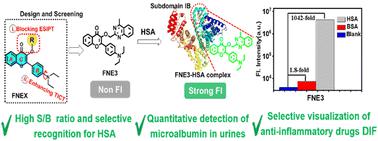当前位置:
X-MOL 学术
›
Mater. Chem. Front.
›
论文详情
Our official English website, www.x-mol.net, welcomes your
feedback! (Note: you will need to create a separate account there.)
Engineering a selective fluorescent sensor with a high signal-to-background ratio for microalbumin detection and imaging
Materials Chemistry Frontiers ( IF 6.0 ) Pub Date : 2022-08-31 , DOI: 10.1039/d2qm00392a Liang Su 1 , Feiyu Yang 1 , Wei Li 1 , Haiyan Li 1 , Chunjiang Wang 2 , Qiuan Wang 1 , Lin Yuan 1
Materials Chemistry Frontiers ( IF 6.0 ) Pub Date : 2022-08-31 , DOI: 10.1039/d2qm00392a Liang Su 1 , Feiyu Yang 1 , Wei Li 1 , Haiyan Li 1 , Chunjiang Wang 2 , Qiuan Wang 1 , Lin Yuan 1
Affiliation

|
Abnormal concentrations of human serum albumin (HSA) are closely related to the occurrence of various diseases, such as liver cirrhosis and kidney disease. Thus, it is of great importance to monitor HSA in body fluids, especially microalbumin in urine. However, due to the interference of other proteins and the low-polar microenvironment, a high signal-to-background (S/B) ratio and selective detection of microalbumin are still a great challenge. To this end, we propose an innovative strategy based on the two-pronged effect of the twisted intramolecular charge transfer (TICT) and the excited state intramolecular proton transfer (ESIPT) mechanisms of flavonoid fluorophores, which is used to significantly improve the signal-to-background ratio of the HSA selective fluorescent sensor. As a proof of strategy demonstration, an HSA specific binding flavonoid molecule (FNE3) was developed by combining chemical design and screening approaches. Due to binding to the new binding site (subdomain IB) of HSA in molecular simulations, FNE3 exhibits a remarkable 1042-fold fluorescence response for HSA but only a 1.8-fold for BSA, which has been the highest S/B ratio among HSA probes so far, enabling highly sensitive differential detection of HSA from other proteins. Moreover, FNE3 is superior to the commercial BCG method in the rapid and sensitive detection of microalbumin in clinical urine samples, and the quantitative detection results were in good agreement with the clinical data. With the excellent performance of FNE3, we further applied it to the selective detection of HSA-specifically bound drugs via a competitive displacement mechanism, and successfully realized the selective visualization of anti-inflammatory drugs diflunisal (DIF) in urine and living cells for the first time. This study indicates that FNE3 may offer a promising tool for the future HSA associated clinical testing and noninvasive pharmaceutical screening.
中文翻译:

设计具有高信背景比的选择性荧光传感器,用于微量白蛋白检测和成像
人血清白蛋白(HSA)浓度异常与肝硬化、肾病等多种疾病的发生密切相关。因此,监测体液中的HSA,尤其是尿液中的微量白蛋白具有重要意义。然而,由于其他蛋白质的干扰和低极性微环境,高信噪比(S/B)和微量白蛋白的选择性检测仍然是一个很大的挑战。为此,我们提出了一种基于类黄酮荧光团的扭曲分子内电荷转移 (TICT) 和激发态分子内质子转移 (ESIPT) 机制的双管齐下的创新策略,用于显着提高信号对-HSA选择性荧光传感器的背景比。作为策略论证的证明,FNE3 ) 是通过结合化学设计和筛选方法开发的。由于在分子模拟中与 HSA 的新结合位点(子域 IB)结合,FNE3对 HSA表现出显着的 1042 倍荧光响应,但对 BSA 仅表现出 1.8 倍,这是 HSA 探针中最高的 S/B 比到目前为止,能够对 HSA 与其他蛋白质进行高度灵敏的差异检测。此外,FNE3在临床尿样中微量白蛋白的快速灵敏检测方面优于商用卡介苗法,定量检测结果与临床数据吻合较好。凭借FNE3的优异性能,我们进一步将其应用于 HSA 特异性结合药物的选择性检测一种竞争性置换机制,首次成功实现了抗炎药物二氟尼柳(DIF)在尿液和活细胞中的选择性可视化。该研究表明,FNE3可能为未来的 HSA 相关临床测试和无创药物筛查提供有前景的工具。
更新日期:2022-08-31
中文翻译:

设计具有高信背景比的选择性荧光传感器,用于微量白蛋白检测和成像
人血清白蛋白(HSA)浓度异常与肝硬化、肾病等多种疾病的发生密切相关。因此,监测体液中的HSA,尤其是尿液中的微量白蛋白具有重要意义。然而,由于其他蛋白质的干扰和低极性微环境,高信噪比(S/B)和微量白蛋白的选择性检测仍然是一个很大的挑战。为此,我们提出了一种基于类黄酮荧光团的扭曲分子内电荷转移 (TICT) 和激发态分子内质子转移 (ESIPT) 机制的双管齐下的创新策略,用于显着提高信号对-HSA选择性荧光传感器的背景比。作为策略论证的证明,FNE3 ) 是通过结合化学设计和筛选方法开发的。由于在分子模拟中与 HSA 的新结合位点(子域 IB)结合,FNE3对 HSA表现出显着的 1042 倍荧光响应,但对 BSA 仅表现出 1.8 倍,这是 HSA 探针中最高的 S/B 比到目前为止,能够对 HSA 与其他蛋白质进行高度灵敏的差异检测。此外,FNE3在临床尿样中微量白蛋白的快速灵敏检测方面优于商用卡介苗法,定量检测结果与临床数据吻合较好。凭借FNE3的优异性能,我们进一步将其应用于 HSA 特异性结合药物的选择性检测一种竞争性置换机制,首次成功实现了抗炎药物二氟尼柳(DIF)在尿液和活细胞中的选择性可视化。该研究表明,FNE3可能为未来的 HSA 相关临床测试和无创药物筛查提供有前景的工具。











































 京公网安备 11010802027423号
京公网安备 11010802027423号